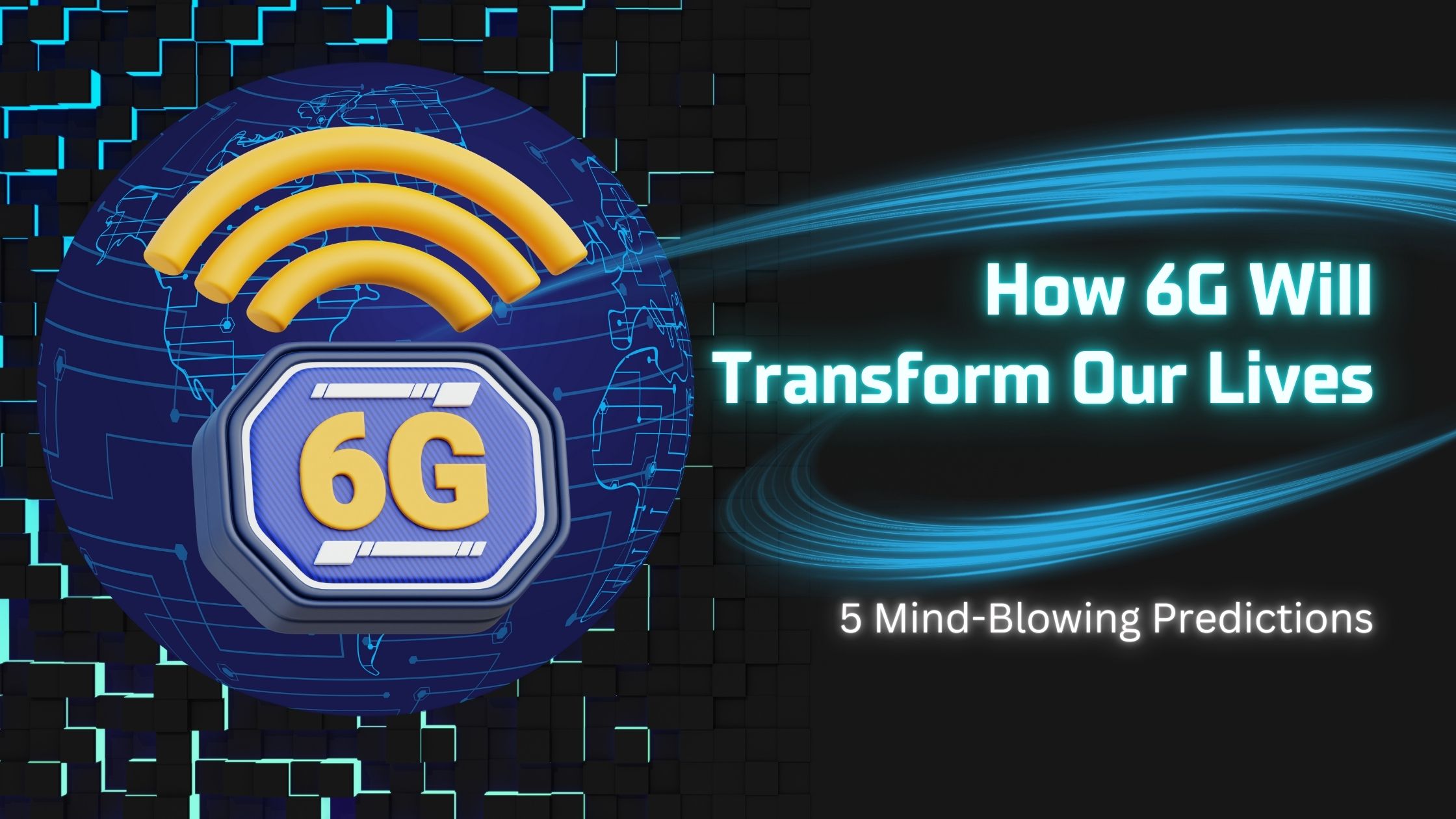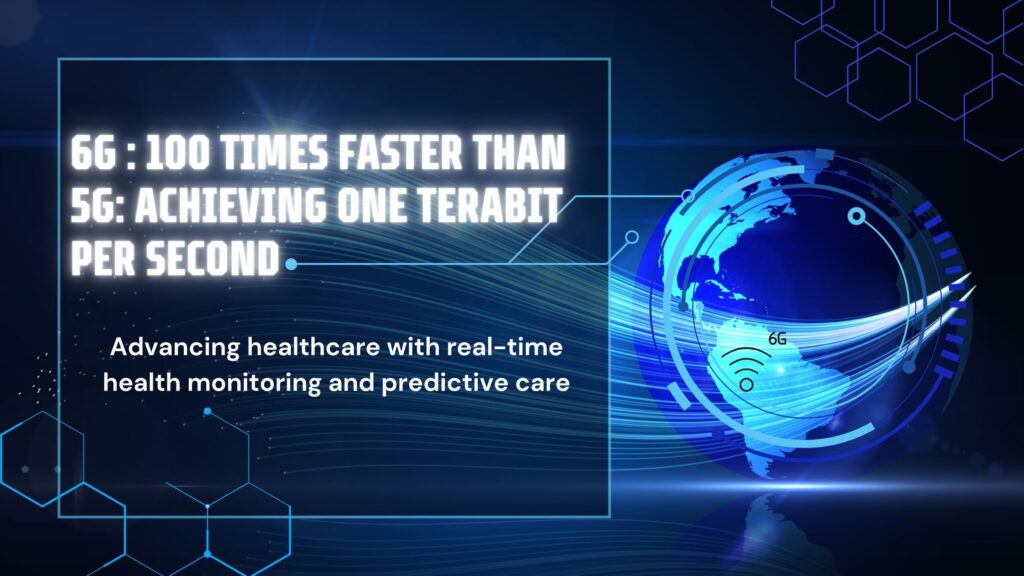How 6G Will Transform Our Lives: 5 Mind-Blowing Predictions

Imagine a world where your thoughts can be transmitted instantly across the globe, where virtual reality feels indistinguishable from reality, and where connectivity is as ubiquitous as the air we breathe. 🌐✨ This isn’t science fiction—it’s the promise of 6G technology, set to revolutionize our lives in ways we can barely fathom.
As 5G continues to reshape our digital landscape, researchers and tech giants are already racing towards the next frontier: 6G. With speeds up to 100 times faster than its predecessor and the potential to connect billions of devices simultaneously, 6G is poised to usher in an era of unprecedented technological advancement. From transforming industries to addressing global connectivity challenges, the impact of 6G will be felt across every aspect of society.
In this blog post, we’ll explore 5 mind-blowing predictions for how 6G will transform our lives. We’ll delve into the revolutionary connectivity it offers, its potential to reshape industries and society, the immersive experiences it will enable, and the challenges and opportunities that lie ahead. Buckle up as we embark on a journey into the not-so-distant future, where the lines between physical and digital realities blur, and the impossible becomes possible. 🚀🔮
Table of Contents
Revolutionizing Connectivity with 6G

A. 100 times faster than 5G: Achieving one terabit per second
6G technology is set to revolutionize connectivity by offering unprecedented speeds, potentially reaching one terabit per second. This represents a monumental leap from 5G, promising data rates that are 100 times faster. To achieve these remarkable speeds, 6G will leverage several key technologies:
- Terahertz (THz) communication: Enabling high-bandwidth applications
- Non-Terrestrial Networks (NTN): Integrating satellite and ground-based networks
- Advanced AI capabilities: Optimizing network performance
These advancements will pave the way for immersive experiences in virtual environments and support the increasing demands of data-intensive applications.
B. Enhanced mobile edge computing for advanced AI capabilities
Mobile Edge Computing (MEC) will play a crucial role in 6G networks, significantly reducing latency and enhancing AI capabilities. Key benefits include:
- Minimized latency for real-time applications
- Improved performance for augmented reality experiences
- Enhanced data processing closer to the user
| Feature | Benefit |
| Proximity to users | Reduced latency |
| Distributed processing | Improved network efficiency |
| AI integration | Automated network optimization |
Vision-Aided Wireless Communication (VAWC) will further enhance communication efficiency through computer vision, while AI and Machine Learning will automate network optimization and error correction.
C. Prioritizing energy efficiency, reliability, and security
6G technology aims to address key concerns in modern telecommunications:
- Energy Efficiency: 6G is expected to enhance energy efficiency compared to previous generations, contributing to sustainability goals.
- Reliability: Technologies like Intent-Based Networking (IBN) and Open Radio Access Network (Open RAN) will improve network reliability and flexibility.
- Security:
- Distributed Ledger Technology (DLT) and blockchain will fortify network security
- Quantum communication promises unprecedented security for sensitive transactions
- Distributed Ledger Technology (DLT) and blockchain will fortify network security
Additionally, 6G will prioritize universal coverage across land, sea, air, and space, ensuring seamless connectivity in even the most remote areas.
With these revolutionary advancements in connectivity, we’ll now explore how 6G will be Transforming Industries and Society, reshaping various sectors and unlocking new possibilities for innovation and efficiency.
Transforming Industries and Society
Now that we’ve explored how 6G will revolutionize connectivity, let’s delve into its transformative impact on industries and society.
A. Advancing healthcare with real-time health monitoring and predictive care
6G’s microsecond latency and terabyte-per-second data rates will revolutionize healthcare. Real-time health monitoring will become ubiquitous, enabling:
- Continuous tracking of vital signs
- Immediate detection of health anomalies
- AI-driven predictive care models
This advanced connectivity will support remote surgeries and instant access to medical expertise, significantly improving patient outcomes.
B. Optimizing urban planning and transportation with 4D mapping
6G’s high-frequency signals and enhanced location services will facilitate precise 4D mapping, transforming urban landscapes:
| Feature | Benefit |
| Real-time traffic management | Reduced congestion and improved air quality |
| Dynamic resource allocation | Efficient energy and water distribution |
| Predictive maintenance | Enhanced infrastructure longevity |
These advancements will lead to smarter, more sustainable cities adaptable to changing needs.
C. Boosting industrial efficiency through IoT and human-machine collaboration
The integration of 6G with IoT and AI will revolutionize industrial processes:
- Enhanced machine-to-machine communication
- Seamless human-machine collaboration
- Real-time data processing and decision-making
This synergy will dramatically increase productivity, reduce waste, and enable more flexible manufacturing processes.
D. Enhancing public safety and emergency response systems
6G’s capabilities will significantly improve public safety and emergency response:
- Ultra-reliable, low-latency communication for first responders
- AI-driven predictive models for disaster prevention
- Seamless integration of terrestrial, aerial, and marine communication platforms
These advancements will enable faster, more coordinated responses to emergencies, potentially saving countless lives.
With these transformative changes in industries and society, 6G will pave the way for immersive experiences that blur the lines between physical and digital realities. Next, we’ll explore how 6G will enable these groundbreaking immersive technologies.
Enabling Immersive Experiences
Now that we’ve explored how 6G will transform industries and society, let’s delve into its potential to enable immersive experiences that will revolutionize the way we interact with digital environments.
Supporting the metaverse with high-speed, low-latency connectivity
6G’s enhanced capabilities will be crucial for realizing the full potential of the metaverse. With data rates potentially 10 to 100 times faster than 5G and significantly lower latency, 6G will provide the foundation for seamless, real-time interactions in virtual spaces. This ultra-fast connectivity will enable:
- High-resolution 3D visuals
- Real-time data handling
- Instantaneous response to user actions
Revolutionizing online meetings with 3D avatars and realistic interactions
The integration of extended reality (XR) and holographic communication in 6G networks will transform online meetings:
| Feature | Benefit |
| 3D avatars | Enhanced non-verbal communication |
| Haptic feedback | Realistic sense of presence |
| Holographic teleconferencing | Immersive, lifelike interactions |
These advancements will make remote collaborations feel as natural and effective as in-person meetings.
Transforming social media into personalized 3D virtual spaces
6G will enable social media platforms to evolve into immersive, three-dimensional environments:
- Personalized virtual spaces for user interactions
- Integration of AI for intelligent content delivery
- Seamless blending of physical and digital realms
This transformation will create more engaging and interactive social experiences, fostering deeper connections in the digital world.
Advancing VR and AR for improved training and skill acquisition
6G’s capabilities will significantly enhance virtual and augmented reality applications:
- Ultra-reliable low latency communication (URLLC) for real-time feedback
- High data throughput for complex, detailed simulations
- Integration with AI for personalized learning experiences
These advancements will revolutionize training and education, allowing for more effective and immersive skill acquisition across various fields.
As we look towards addressing global connectivity challenges, the immersive experiences enabled by 6G will play a crucial role in bridging geographical and cultural divides, creating new opportunities for global collaboration and understanding.
Addressing Global Connectivity Challenges
Now that we’ve explored the immersive experiences enabled by 6G, let’s turn our attention to how this technology will address global connectivity challenges. The future of wireless networks promises to bridge the digital divide and revolutionize connectivity on a global scale.
A. Expanding broadband access to underserved areas
6G technology aims to tackle one of the most pressing issues in modern telecommunications: providing reliable internet access to underserved areas. Unlike its predecessors, 6G will focus on:
- Targeting specific sectors such as healthcare, smart cities, and industrial automation
- Ensuring seamless user experiences across urban, rural, and indoor environments
- Promoting collaboration among various wireless networks
This targeted approach will help extend broadband access to regions that have long been left behind in the digital revolution, potentially transforming lives and economies in these areas.
B. Utilizing low latency satellite technology and intelligent surfaces
To achieve truly global connectivity, 6G will leverage advanced technologies:
| Technology | Benefits |
| Low latency satellite | Provides coverage in remote areas |
| Intelligent surfaces | Enhances signal propagation and reception |
These innovations will work in tandem with existing infrastructure to create a more robust and far-reaching network. The integration of Wi-Fi, cellular, and other wireless technologies will ensure cost-effective and operationally efficient solutions for operators to meet growing data demands sustainably.
C. Facilitating wireless charging for low-power IoT devices
6G’s capabilities extend beyond just connectivity. One of the most exciting prospects is the potential for:
- Wireless charging of low-power IoT devices
- Enhanced energy efficiency compared to previous generations
- Sustainable solutions for the increasing number of connected devices
This feature will be particularly crucial as the Internet of Things continues to expand, enabling a vast network of sensors and devices to operate with minimal maintenance and reduced environmental impact.
As we look towards the future of 6G, it’s clear that addressing global connectivity challenges is just one piece of the puzzle. In the next section, we’ll explore the challenges and opportunities that lie ahead in navigating this revolutionary technology.
Navigating Challenges and Opportunities
As we transition from addressing global connectivity challenges, it’s crucial to navigate the potential hurdles and opportunities that come with the development of 6G technology. The IEEE, as the largest technical professional organization dedicated to advancing technology for humanity, has identified several critical challenges that need to be addressed for the successful implementation of 6G wireless systems.
A. Addressing privacy concerns and data protection regulations
Privacy and data protection are paramount concerns in the development of 6G technology. As wireless systems become more sophisticated, the amount of personal data transmitted and processed will increase exponentially. To address this challenge, stakeholders must:
- Develop robust data protection frameworks
- Implement strict privacy policies
- Ensure compliance with evolving regulations
B. Managing infrastructure upgrades and associated costs
The transition to 6G will require significant infrastructure upgrades, which come with substantial costs. To manage this challenge effectively:
| Strategy | Description |
| Phased rollout | Implement 6G infrastructure in stages to spread costs over time |
| Public-private partnerships | Collaborate with governments and private sector to share financial burden |
| Leverage existing infrastructure | Utilize and upgrade current 5G networks where possible |
C. Ensuring robust cybersecurity measures
As 6G networks become more complex and interconnected, ensuring robust cybersecurity becomes increasingly critical. Key focus areas include:
- Developing advanced encryption protocols
- Implementing AI-powered threat detection systems
- Conducting regular security audits and vulnerability assessments
- Fostering international cooperation on cybersecurity standards
D. Promoting sustainable and energy-efficient practices
Sustainability and energy efficiency are crucial considerations in the development of 6G technology. To address this challenge:
- Design energy-efficient network components
- Implement smart power management systems
- Explore renewable energy sources for network infrastructure
- Develop recycling programs for outdated equipment
By addressing these critical challenges, the IEEE and other stakeholders can pave the way for a successful and beneficial implementation of 6G technology, ensuring that it truly advances technology for the benefit of humanity.
Conclusion
The advent of 6G technology promises to revolutionize our world in ways we can scarcely imagine. From transforming industries and enabling immersive experiences to addressing global connectivity challenges, 6G will usher in a new era of seamless connectivity and unprecedented technological capabilities. With speeds up to 100 times faster than 5G and the ability to support advanced applications like the metaverse, 6G will reshape how we work, communicate, and interact with our environment.
As we look towards the future, it’s crucial to navigate the challenges and opportunities that 6G presents. While concerns about privacy, infrastructure costs, and regulatory requirements exist, the potential benefits in healthcare, urban planning, and industrial automation are immense. As stakeholders in this evolving landscape, we must stay informed about 6G developments, plan for its integration, and advocate for responsible implementation. The transformative power of 6G is on the horizon, promising to create a more interconnected and efficient world that will reshape our lives in ways we’re only beginning to comprehend.






